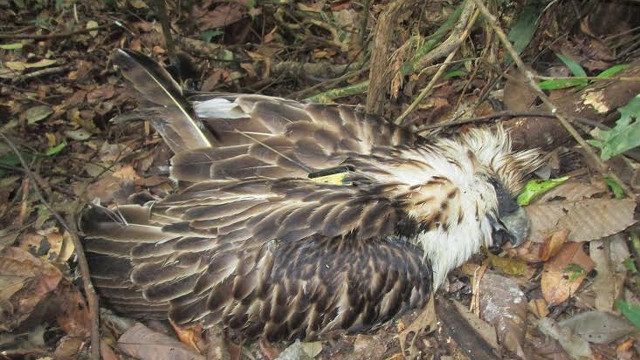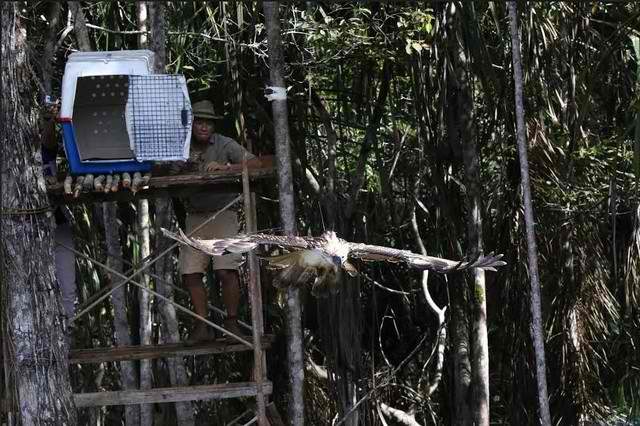SUMMARY
This is AI generated summarization, which may have errors. For context, always refer to the full article.

MANILA, Philippines (UPDATED) – A critically-endangered Philippine eagle just recently released into the wild was found shot dead in Mount Hamiguitan Range, a UNESCO World Heritage Site in Davao Oriental.
The eagle, named “Pamana (Legacy)” by conservationists, was found with a bullet hole in her right breast that shattered her left shoulder, said Dennis Salvador, Executive Director of the Philippine Eagle Foundation.
A metal fragment believed to be from a shattered gun pellet was also found in the carcass.
Scientists from PEF found her body on August 16 after the tracker they had outfitted her with went into mortality mode – a signal that she was dead.
Her body was already decomposing when they found it near a creek below thick forests.
PEF released Pamana into the wild only in June 12, in honor of Philippine Independence Day. She was around 3 years old at the time of her death. The site where she was found was only one kilometer from where they had released her, said Salvador.

Salvador said they deferred announcing her death to Wednesday, August 19, after they finished conducting a necropsy to confirm the cause of death.
The bullet that killed Pamana came from an airgun, a weapon commonly used to kill Philippine eagles, said Salvador. He said they are not able to determine who is responsible for her death.
This is not the first time Pamana has suffered from human-inflicted injuries. In 2012, she was found in Iligan City with superficial gunshot wounds and minor bruises. She was brought to the PEF rehabilitation facility in Davao City where they nursed her back to health until her release last June.
Government officials also mourned the loss of one of the country’s few remaining eagles.
“We are saddened and strongly condemn the killing of Pamana. It is unfortunate that despite increased awareness and intensive information campaign, we continue to encounter such loss of magnificent and valuable wildlife,” said Biodiversity Management Bureau chief Theresa Mundita Lim in a text message to Rappler.
She said Department of Environment and Natural Resources Region 11, along with PEF, will conduct an investigation on who was responsible for the eagle’s death.
Hunting in a protected area?
The death of a Philippine eagle (scientific name Pithecophaga jefferyi) in Mount Hamiguitan comes as a shock because it is one of the country’s protected areas.
In fact, PEF chose to release Pamana in the mountain range specifically because of strong local commitment to protect the area.
But initial findings show that Pamana was shot near the fringes of the protected mountain range – a buffer zone “accessible to anyone,” Lim said.
“Fragmenting or shrinking of range area, encroachment, and scarcity of food sometimes drives the eagle to open areas which exposes it increasingly to poachers and irresponsible gun owners,” she explained.
PEF had plans to release even more Philippine eagles there in Mount Hamiguitan in the future. But now, they want the threats to be addressed first.
“Yes, we can release again but not until these threats are sufficiently addressed,” said Salvador.
Davao Oriental local governments and the national government have allotted funds for protection and conservation. Part of these funds go to forest guards in charge of, among other things, ensuring poaching does not happen within the park.
But the killing of Pamana shows the protection measures in the mountain range are far from sufficient.
“We have to get rid of this culture of paper protection and cosmetics on the way we manage our natural heritage. If we lose these treasures, there is no way anyone can recreate it,” said Salvador.
The mountain is also the country’s most recently declared UNESCO World Heritage Site, an honor that puts it among the world’s most important ecosystems.
One of the reasons for its spot on the list is its reputation as a habitat of the Philippine eagle, one of the rarest raptors in the world and the country’s national bird.
It is classified as “critically-endangered” or close to extinction by the International Union for Conservation of Nature. Only found in the Philippines, only around 400 pairs are left in the wild.
The Philippine eagle population is threatened by loss of habitat due to deforestation and poaching. – Rappler.com
Add a comment
How does this make you feel?
There are no comments yet. Add your comment to start the conversation.